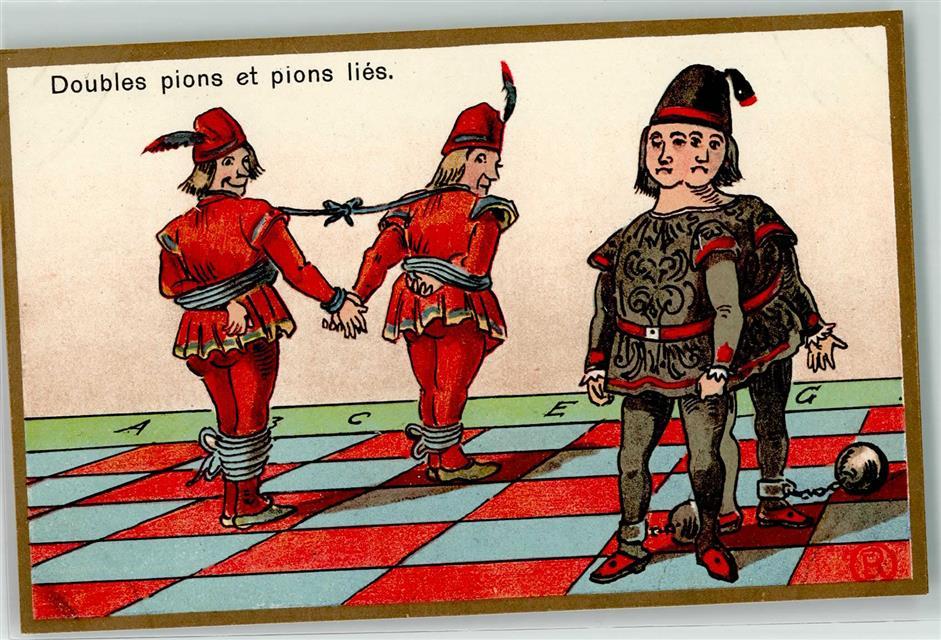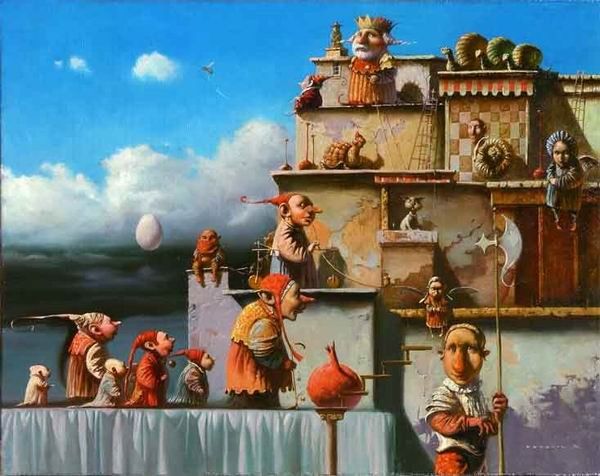
Pawns Adventures: Always Act from Position of Strength!
Intended level: Beginner/Early Intermediate
Building Up Strength
You are starting a new game. What should be the first thought that guides you through the initial stage of battle?
You know it is important to bring out your pieces quickly and effectively. You have been told to control the center. But just WHY is it important to control the center?
 No battering rams, no pawn breaks, no hostilities as they unite here in their chess suffering and sacrifices
No battering rams, no pawn breaks, no hostilities as they unite here in their chess suffering and sacrifices
.
In any battle you fight in life you need to act from the position of strength.
How do you achieve this key requirement in the beginning of chess battle? By constructing a strong pawn structure in the center of the battlefield. This is in accordance with the main principle of strategy: restrict the other army, put the brake on them, do not let them expand!
How do you establish this credibility in the middle? By using your resources best suited for the job. Your pawns! Your first task as a commander-in-chief of your chess army is to make a decision on how your pawn troops will be deployed. They are the backbone that will be giving strength to your entire position. Depending on the pawn formation adopted, you will then mobilize your pieces to take up effective positions in accord with your intentions to ensure a good coordination of your troops.
This will impact stability of your position and allow you to:
(1) make preparations for and to support your future expansion and assault on the enemy base (for example starting with a pawn breakthrough in the center after your pieces have safely regrouped behind the pawn screen),
(2) to oppose external, disruptive forces — the strong center will be a wall that holds the enemy army back and keep them from conquering your territory by launching an attack against you.
You see there are very important, both attacking and defensive roles that pawns have. This is exactly why Philidor famously said: “Pawns are the very life of this game. They alone form attack and defense.”
.
The Battering Ram
To build up the strong presence in the center you usually create strong e4, or d4 post (e5, d5 for Black). For example, the structure Pe4, Pd3, Nc3, Bg2, Re1 will give your fighting forces a necessary unity and cohesion.
Let us say that the game started 1.e4 e5. Amazingly enough, the strategic plan for White has been set right after the first move by Black.
 Opposing pawns as fighting rams. This set-up means immobility, which favors the defender
Opposing pawns as fighting rams. This set-up means immobility, which favors the defender
.
We now see the two opposing pawns as fighting rams. Rams in general cause immobility. They separate the opposing armies, thus favoring the defender. The ram is an obstacle that you would like to remove. The principal objective in all openings with 1.e4 e5 is to get rid of the opponent's King pawn. The task is to compel the defender to give up his strong center position. For attacking purposes, it is important to avoid rams and strive for the dissolution of existing ones.
How can White combat the opposing e5-pawn?
You may go for the straight elimination (2.Qh5 and 3.Qxe5), but life may not be that easy. How can you at least begin a battle against the enemy pawn on e5?
.
Lever as Pawn Breaker
White can achieve his aim only by playing d2-d4 (or f2-f4). This situation in which two opposing pawns can capture each other is called lever (term Hans Kmoch coined in his Pawn Power in Chess), or simply pawn break (any advanced pawn actually becomes a possible "hook" for a lever). Lever creates a tension which may or may not explode in capture.
 Lever creates tension and makes possible opening up lines to activate pieces
Lever creates tension and makes possible opening up lines to activate pieces
.
The ability to create tension by using lever is one of the greatest skills you need in chess as far as pawn play and how to steer game's strategic direction are concerned.
Any attacking strategy must include creating pawn breaks to open up lines for your troops and activate your army’s potential. It is actually the main mechanism of the counterattack which, as is well known, is the strongest form of attack. It is critically important for you to understand the pawn play if you aspire for any improvement in the game. After tactics, the pawn play is probably the most important thing in chess (Hans Berliner, The System).
Back to the first diagram, White’s major goal is to to exchange the enemy e5 pawn for his Queen Pawn (or King's Bishop Pawn). Why? Because by doing so you set up the pawn structure where your plus is derived from the powerful e4-pawn in the center which gives you greater mobility. Thus the basic factor is not the abstract having a foot soldier in the middle: it is, instead, that the total mobility of your army is greater because of that pawn.
There are two types of defense which Black may adopt. The first is the strong point method where he retains a pawn at e5 come what may. The second is counter-attack, where he relinquishes his e5-pawn to initiate an attack on the e4-pawn along the just opened e-file (of course, pawn break with d5, or f5, is indispensable here). This will compel White to give up his e4-pawn, or to weaken his position otherwise.
.
This is a slightly revised guest post on ichess.net published on March 11, 2012, and later in Spanish on ichess.es (the updated Spanish version was posted on this site earlier today).
Here I am adding an instructive game showing how the pawn play is revolving around creating/exploiting LEVER in the never-stopping war being fought for gaining initiative/activity for your men.
.
Here is my improvement advice for beginning to intermediate chess players again: studying chess tactics (together with other important subjects, of course) is essential, but the strong pawn play — having such a big strategic significance — can only make spectacular tactical fireworks happen!
..
Further reading on lever:
